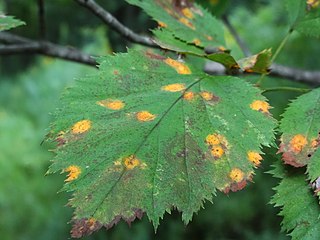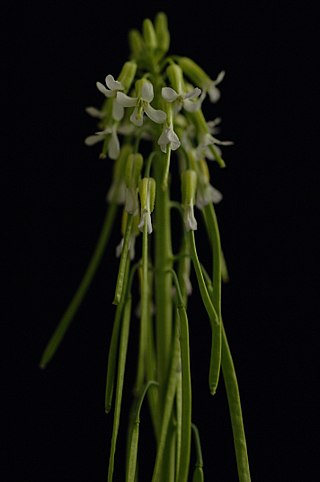
Basidiomycota is one of two large divisions that, together with the Ascomycota, constitute the subkingdom Dikarya within the kingdom Fungi. Members are known as basidiomycetes. More specifically, Basidiomycota includes these groups: agarics, puffballs, stinkhorns, bracket fungi, other polypores, jelly fungi, boletes, chanterelles, earth stars, smuts, bunts, rusts, mirror yeasts, and Cryptococcus, the human pathogenic yeast.

Rusts are fungal plant pathogens of the order Pucciniales causing plant fungal diseases.

Teliospore is the thick-walled resting spore of some fungi, from which the basidium arises.

Gymnosporangium globosum is a fungal plant pathogen that causes cedar-hawthorn rust.

Gymnosporangium juniperi-virginianae is a plant pathogen that causes cedar-apple rust. In virtually any location where apples or crabapples (Malus) and eastern red cedar coexist, cedar apple rust can be a destructive or disfiguring disease on both the apples and cedars. Apples, crabapples, and eastern red cedar are the most common hosts for this disease. Similar diseases can be found on quince and hawthorn and many species of juniper can substitute for the eastern red cedars.
Puccinia cacabata is a fungal species and plant pathogen that causes rust on cotton. It was originally found on the leaves of Chloris ciliata in Bolivia.
Puccinia schedonnardii is a basidiomycete fungus that affects cotton. More commonly known as a “rust,” this pathogen typically affects cotton leaves, which can decrease the quality of the boll at time of harvest. As large percentages of cotton in the United States are resistant to various rust varieties, there is little economic importance to this disease. In places where rust is prevalent, however, growers could see up to a 50% reduction in yield due to rust infection.

Puccinia asparagi is the causative agent of asparagus rust. It is an autoecious fungus, meaning that all stages of its life cycle – pycniospores, aeciospores, and teliospores – all develop upon the same host plant . Rust diseases are among the most destructive plant diseases, known to cause famine following destruction of grains, vegetables, and legumes. Asparagus rust occurs wherever the plant is grown and attacks asparagus plants during and after the cutting season. Asparagus spears are usually harvested before extensive rust symptoms appear. Symptoms are first noticeable on the growing shoots in early summer as light green, oval lesions, followed by tan blister spots and black, protruding blisters later in the season. The lesions are symptoms of Puccinia asparagi during early spring, mid-summer and later summer to fall, respectively. Severe rust infections stunt or kill young asparagus shoots, causing foliage to fall prematurely, and reduce the ability of the plant to store food reserves. The Puccinia asparagi fungus accomplishes this by rust lowering the amounts of root storage metabolites. The infected plant has reduced plant vigor and yield, often leading to death in severe cases. Most rust diseases have several stages, some of which may occur on different hosts; however, in asparagus rust all the life stages occur on asparagus. Because of this, many observers mistake the different stages of the Puccinia asparagi life cycle as the presence of different diseases. The effects of Puccinia asparagi are present worldwide wherever asparagus is being grown. Asparagus rust is a serious threat to the asparagus industry.

Puccinia coronata is a plant pathogen and causal agent of oat and barley crown rust. The pathogen occurs worldwide, infecting both wild and cultivated oats. Crown rust poses a threat to barley production, because the first infections in barley occur early in the season from local inoculum. Crown rusts have evolved many different physiological races within different species in response to host resistance. Each pathogenic race can attack a specific line of plants within the species typical host. For example, there are over 290 races of P. coronata. Crops with resistant phenotypes are often released, but within a few years virulent races have arisen and P. coronata can infect them.

Puccinia helianthi is a macrocyclic and autoecious fungal plant pathogen that causes rust on sunflower. It is also known as "common rust" and "red rust" of sunflower.

Gymnosporangium sabinae is a species of rust fungus in the subdivision Pucciniomycotina. Known as pear rust, European pear rust, or pear trellis rust, it is a heteroecious plant pathogen with Juniperus sabina as the main primary (telial) host and Pyrus communis as the main secondary (aecial) host.

Boechera holboellii, or Holbøll's rockcress, is a species of plant in the family Brassicaceae. Its cytology has been much studied by the Danish botanist Tyge W. Böcher. Circumscription of this species has varied, with earlier works treating it as a widespread, polymorphic species with several varieties, while more recently it has been treated as a much more narrowly defined species from Greenland.

Puccinia horiana is a species of fungus that causes chrysanthemum white rust, is a disease of plant species of the genus Chrysanthemum.

Puccinia poarum, a species of fungus, known as the coltsfoot gall rust, or meadow grass rust, is a plant pathogen. This fungal parasite forms a yellow to orange gall, 1–2 cm in diameter, on the underside of leaves of coltsfoot. It also infects but does not gall grasses of the family Poaceae. P. poarum is a genetically diverse species that has been reported on at least seventy plant hosts. It was originally found on Poa fertilis and Poa nemoralis in Denmark in 1877.

Austropuccinia is a monotypic genus of rust native to South America with the only species Austropuccinia psidii, commonly known as myrtle rust, guava rust, or ʻōhiʻa rust. It affects plants in the family Myrtaceae. It is a member of the fungal complex called the guava rust group. The spores have a distinctive yellow to orange colour, occasionally encircled by a purple ring. They are found on lesions on new growth including shoots, leaves, buds and fruits. Leaves become twisted and may die. Infections in highly susceptible species may result in the death of the host plant.

Telium, plural telia, are structures produced by rust fungi as part of the reproductive cycle. They are typically yellow or orange drying to brown or black and are exclusively a mechanism for the release of teliospores which are released by wind or water to infect the alternate host in the rust life-cycle. The telial stage provides an overwintering strategy in the life cycle of a parasitic heteroecious fungus by producing teliospores; this occurs on cedar trees. A primary aecial stage is spent parasitizing a separate host plant which is a precursor in the life cycle of heteroecious fungi. Teliospores are released from the telia in the spring. The spores can spread many kilometers through the air, however most are spread near the host plant.
Spruce broom rust or yellow witches' broom rust is a fungal plant disease caused by the basidiomycete fungus known as Chrysomyxa arctostaphyli. It occurs exclusively in North America, with the most concentrated outbreaks occurring in northern Arizona and southern Colorado on blue and Engelmann spruce, as well as in Alaska on black and white spruce. This disease alternates its life cycle between two hosts, with the spruce serving as the primary host and bearberry serving as the secondary or alternate host. The name for the disease comes from the distinctive “witches broom”, commonly yellow in color, which forms on the spruce after young needles have been infected. Management must be carried out through physical or mechanical methods, such as the pruning of brooms or the removal of the secondary host from the area, because no chemical control measures have yet been determined to be economically effective. Generally, spruce broom rust is seen as a mostly cosmetic issue, and it is very rarely the direct cause of tree death; however, research has shown a reduction in overall productivity and health of infected trees, making it an important issue for logging and timber companies.
Melampsora amygdalinae is a fungal pathogen and part of the division Basidiomycota. It is known as a rust fungus that is host specific. M. amygdalinae commonly infects willows of the genus Salix. This fungus was first discovered in 1909 by Heinrich Klebahn who was a professor of soil biology in Hamburg. Neimi at el. explain how the pathogen occurs throughout the whole distribution of the host, and the small natural populations are an area of interest. This rust fungus is annual and autoecious, which references the fungus spending its entire life in a single host.

Puccinia sorghi, or common rust of maize, is a species of rust fungus that infects corn and species from the plant genus Oxalis.

Cronartium quercuum, also known as pine-oak gall rust is a fungal disease of pine and oak trees. Similar to pine-pine gall rust, this disease is found on pine trees but its second host is an oak tree rather than another pine.
















